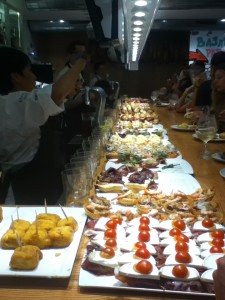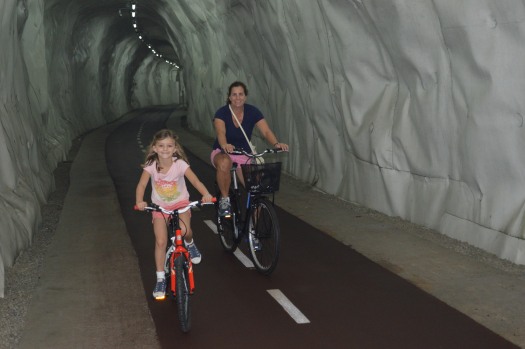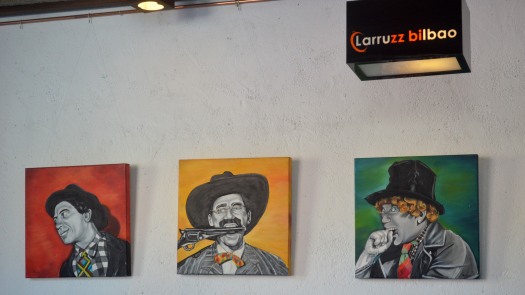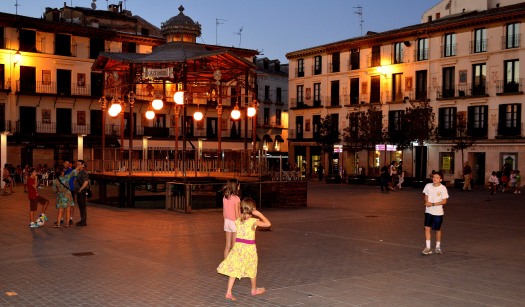How to Stay Entertained in the Car
Aug 25th, 2013 by willmarks
The return stretch back toward Barcelona kept in mind that we would later see much of Spain, our home for the next year. Thus, for a more unique experience, we traveled along the French Pyrenees to Ax-les-Thermes, a ski village almost 400 kilometers due East, from the Atlantic Coast toward the Mediterranean Coast.
Lengthy drives require strong parenting skills, including proper video/technology allocation as well as spacing between meals and bathroom breaks. One would hope that 500-year old castles and churches would be of interest, and they are, but even powerful history cannot prevent the “when are we going to be there?” that we all know so well. While reading a book (or kindle) is always an option, motion sickness often prevents this. Maggie has found a good way to stay busy when certain devices are off limits. She actually watches reruns of her favorite TV shows in her head, really, absent any technology. She notes that some of her favorites include Modern Family (ok, our fault for letting a 7-year-old see the real thing from time to time, but it’s a family show in our house), Phineas and Ferb, SpongeBob, Dog with a Blog and Good Luck Charlie; and she says she can pause, rewind, fast forward at any time and doesn’t need to watch any commercials. On this particular drive, she watched an episode of Phineas and Ferb when they were cavemen.
Ax-les-Thermes exists as a ski town, a locale through which the Tour de France sometimes passes, and as the home of long standing thermal baths. I believe “Ax” comes from water and “Thermes” hot springs. I wouldn’t call the town picturesque (versus other mountain villages), except when looking up into the mountains. The ski area itself, not necessarily well known, claims more than 1,000 meters vertical (over 3,000 feet) and has 17 lifts. In the U.S., we tend to hear about the Alps, but not so much about the quality ski mountains in the Pyrenees.
As for our short visit, we did soak our legs in the springs, but the comfort of the hot water was offset by the unpleasant smell of sulphur. Assume the gap is where Max, the photographer, had been sitting.
We were told that the town’s baths, which have evolved into a spa industry of some sort, have been around since the medieval period, when they were used to treat soldiers with leprosy.
Against what would have been better judgment, we followed up our stay in Ax-les-Thermes with a visit to the Grotte de Lombrives, a cave nearby in the Pyrenees, claiming to be the largest in Europe. Unfortunately, the 2-hour tour lasted 3 hours and there was no way out (envision a child that needs to use the restroom). And, there were no paintings in these caves, only stalactites and stalagmites, which can be seen and appreciated in less than 30 minutes. That is all the time I needed to remember, once and for all, I hope, that stalactites hang from the ceiling (there is a “c” in stalactites) and stalagmites rise from the ground (note the “g” in stalagmites). Do not go to Grotte de Lombrives!

 Giving up on me, Evelyn booked a great San Sebastian apartment for the next two nights using Airbnb. San Sebastian was wonderful, as expected, with large beaches and pintxos galore (web definition: a “thorn” or “spike” or a small snack, typically eaten in bars, traditional in northern Spain and especially popular in the Basque country and Navarre).
Giving up on me, Evelyn booked a great San Sebastian apartment for the next two nights using Airbnb. San Sebastian was wonderful, as expected, with large beaches and pintxos galore (web definition: a “thorn” or “spike” or a small snack, typically eaten in bars, traditional in northern Spain and especially popular in the Basque country and Navarre).



